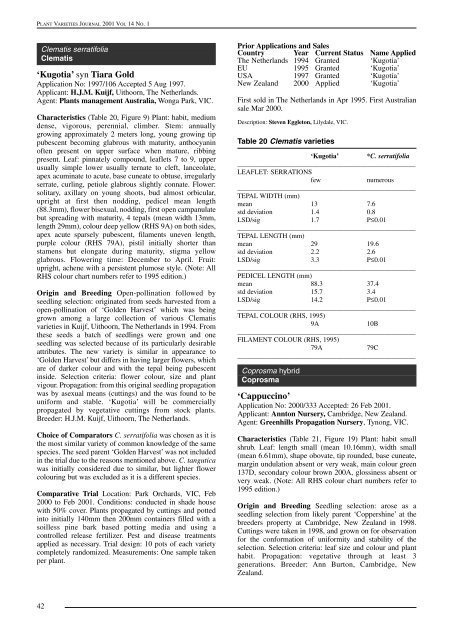49. Volume 14- Number 1 - IP Australia
49. Volume 14- Number 1 - IP Australia
49. Volume 14- Number 1 - IP Australia
Create successful ePaper yourself
Turn your PDF publications into a flip-book with our unique Google optimized e-Paper software.
PLANT VARIETIES JOURNAL 2001 VOL <strong>14</strong> NO. 1<br />
Clematis serratifolia<br />
Clematis<br />
‘Kugotia’ syn Tiara Gold<br />
Application No: 1997/106 Accepted 5 Aug 1997.<br />
Applicant: H.J.M. Kuijf, Uithoorn, The Netherlands.<br />
Agent: Plants management <strong>Australia</strong>, Wonga Park, VIC.<br />
Characteristics (Table 20, Figure 9) Plant: habit, medium<br />
dense, vigorous, perennial, climber. Stem: annually<br />
growing approximately 2 meters long, young growing tip<br />
pubescent becoming glabrous with maturity, anthocyanin<br />
often present on upper surface when mature, ribbing<br />
present. Leaf: pinnately compound, leaflets 7 to 9, upper<br />
usually simple lower usually ternate to cleft, lanceolate,<br />
apex acuminate to acute, base cuneate to obtuse, irregularly<br />
serrate, curling, petiole glabrous slightly connate. Flower:<br />
solitary, axillary on young shoots, bud almost orbicular,<br />
upright at first then nodding, pedicel mean length<br />
(88.3mm), flower bisexual, nodding, first open campanulate<br />
but spreading with maturity, 4 tepals (mean width 13mm,<br />
length 29mm), colour deep yellow (RHS 9A) on both sides,<br />
apex acute sparsely pubescent, filaments uneven length,<br />
purple colour (RHS 79A), pistil initially shorter than<br />
stamens but elongate during maturity, stigma yellow<br />
glabrous. Flowering time: December to April. Fruit:<br />
upright, achene with a persistent plumose style. (Note: All<br />
RHS colour chart numbers refer to 1995 edition.)<br />
Origin and Breeding Open-pollination followed by<br />
seedling selection: originated from seeds harvested from a<br />
open-pollination of ‘Golden Harvest’ which was being<br />
grown among a large collection of various Clematis<br />
varieties in Kuijf, Uithoorn, The Netherlands in 1994. From<br />
these seeds a batch of seedlings were grown and one<br />
seedling was selected because of its particularly desirable<br />
attributes. The new variety is similar in appearance to<br />
‘Golden Harvest’ but differs in having larger flowers, which<br />
are of darker colour and with the tepal being pubescent<br />
inside. Selection criteria: flower colour, size and plant<br />
vigour. Propagation: from this original seedling propagation<br />
was by asexual means (cuttings) and the was found to be<br />
uniform and stable. ‘Kugotia’ will be commercially<br />
propagated by vegetative cuttings from stock plants.<br />
Breeder: H.J.M. Kuijf, Uithoorn, The Netherlands.<br />
Choice of Comparators C. serratifolia was chosen as it is<br />
the most similar variety of common knowledge of the same<br />
species. The seed parent ‘Golden Harvest’ was not included<br />
in the trial due to the reasons mentioned above. C. tangutica<br />
was initially considered due to similar, but lighter flower<br />
colouring but was excluded as it is a different species.<br />
Comparative Trial Location: Park Orchards, VIC, Feb<br />
2000 to Feb 2001. Conditions: conducted in shade house<br />
with 50% cover. Plants propagated by cuttings and potted<br />
into initially <strong>14</strong>0mm then 200mm containers filled with a<br />
soilless pine bark based potting media and using a<br />
controlled release fertilizer. Pest and disease treatments<br />
applied as necessary. Trial design: 10 pots of each variety<br />
completely randomized. Measurements: One sample taken<br />
per plant.<br />
Prior Applications and Sales<br />
Country Year Current Status Name Applied<br />
The Netherlands 1994 Granted ‘Kugotia’<br />
EU 1995 Granted ‘Kugotia’<br />
USA 1997 Granted ‘Kugotia’<br />
New Zealand 2000 Applied ‘Kugotia’<br />
First sold in The Netherlands in Apr 1995. First <strong>Australia</strong>n<br />
sale Mar 2000.<br />
Description: Steven Eggleton, Lilydale, VIC.<br />
Table 20 Clematis varieties<br />
‘Kugotia’ *C. serratifolia<br />
____________________________________________________<br />
LEAFLET: SERRATIONS<br />
few<br />
numerous<br />
____________________________________________________<br />
TEPAL WIDTH (mm)<br />
mean 13 7.6<br />
std deviation 1.4 0.8<br />
LSD/sig 1.7 P≤0.01<br />
____________________________________________________<br />
TEPAL LENGTH (mm)<br />
mean 29 19.6<br />
std deviation 2.2 2.6<br />
LSD/sig 3.3 P≤0.01<br />
____________________________________________________<br />
PEDICEL LENGTH (mm)<br />
mean 88.3 37.4<br />
std deviation 15.7 3.4<br />
LSD/sig <strong>14</strong>.2 P≤0.01<br />
____________________________________________________<br />
TEPAL COLOUR (RHS, 1995)<br />
9A<br />
10B<br />
____________________________________________________<br />
FILAMENT COLOUR (RHS, 1995)<br />
79A<br />
79C<br />
____________________________________________________<br />
Coprosma hybrid<br />
Coprosma<br />
‘Cappuccino’<br />
Application No: 2000/333 Accepted: 26 Feb 2001.<br />
Applicant: Annton Nursery, Cambridge, New Zealand.<br />
Agent: Greenhills Propagation Nursery, Tynong, VIC.<br />
Characteristics (Table 21, Figure 19) Plant: habit small<br />
shrub. Leaf: length small (mean 10.16mm), width small<br />
(mean 6.61mm), shape obovate, tip rounded, base cuneate,<br />
margin undulation absent or very weak, main colour green<br />
137D, secondary colour brown 200A, glossiness absent or<br />
very weak. (Note: All RHS colour chart numbers refer to<br />
1995 edition.)<br />
Origin and Breeding Seedling selection: arose as a<br />
seedling selection from likely parent ‘Coppershine’ at the<br />
breeders property at Cambridge, New Zealand in 1998.<br />
Cuttings were taken in 1998, and grown on for observation<br />
for the conformation of uniformity and stability of the<br />
selection. Selection criteria: leaf size and colour and plant<br />
habit. Propagation: vegetative through at least 3<br />
generations. Breeder: Ann Burton, Cambridge, New<br />
Zealand.<br />
42

















